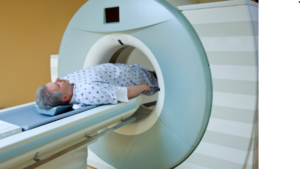Spotlight on Prostate Cancer
Spotlight on Prostate Cancer
The prostate is a walnut-sized gland located between the bladder and the penis. The prostate is only found in men, is just in front of the rectum and forms part of the male reproductive system. The urethra runs through the middle of the prostate, from the bladder to the penis, allowing urine to flow out of the body.
Prostate cancer occurs when abnormal cells in the prostate gland grow more quickly and uncontrollably compared to in a healthy prostate. It is generally a slow-growing disease, and many people with low-grade prostate cancer live without symptoms or it spreading for years. However, high-grade prostate cancer can spread rapidly and become life-threatening, making timely and appropriate management crucial.
Prostate cancer is the most commonly diagnosed cancer Australia. It is more prevalent in older people, with 71 per cent of cases diagnosed in people over 65 years of age. People with prostates have a one in six risk of being diagnosed by the age of 85.
In 2024, there were an estimated 3,901 deaths from prostate cancer, and an estimated 26,368 new cases diagnosed. Thanks to advances in research and treatment, nearly all patients who present with localised disease will live beyond five years. The survival rate has significantly improved over the years, rising from 60 percent to 96 percent.
Early prostate cancer usually does not display symptoms. Advanced prostate cancer symptoms can include:
- Frequent urination, particularly at night;
- Pain on urination;
- Blood in the urine;
- A weak urine stream;
- Pain in the pelvis or back
- Weak legs or feet
More widespread disease often spreads to the bones and causes unexplained weight loss, fatigue and pain.
Your risk of prostate cancer can be increased by some of the factors below:
- Age, increasing greatly if you are aged over 50 years;
- Family history of prostate, breast or ovarian cancer, especially BRCA1 and BRCA2 gene mutations;
- A brother or father diagnosed with prostate cancer before the age of 60 years
There is also an association with high testosterone levels.
Treatment and care of people with cancer is usually provided by a multidisciplinary team, i.e a team of health professionals, both medical and allied health. Your health care team will help decide the most optimal course of treatment and take into consideration:
- the stage of the disease
- the location of the cancer
- the severity of symptoms
- your general health and wishes.
Treatment may take various forms and may not be recommended straight away. Options include:
- Watchful waiting where you might be monitored in case symptoms develop or change.
- Active surveillance when you will likely have regular blood tests to check your PSA level, regular digital rectal examinations, and maybe ultrasounds or biopsies. If the cancer starts to grow or there are signs it is worsening, you might begin treatment.
- Surgery will become an option if the tumour has not spread outside the prostate. The prostate and some of the surrounding tissue will be removed, including the seminal vesicles. This is called a radical prostatectomy.
 Radiotherapy can take two forms:
Radiotherapy can take two forms:
- external beam radiation therapy – where a machine outside the body directs radiation towards the prostate gland
- internal radiation therapy (brachytherapy) – where small radioactive ‘seeds’ are placed inside the prostate.
- Cryosurgery involves inserting long needles through the perineum into the prostate. Very cold gases are then passed through the needles, which freezes the prostate and destroys cancer cells.
- Hormone therapy involves reducing the levels of certain hormones in the body, so the cancer can slow its growth or even shrink. Hormone therapy for prostate cancer is also called androgen deprivation therapy (ADT).
- Chemotherapy can also be used to treat prostate cancer.
New drugs and treatment approaches are constantly being developed and researched. New combinations of different strategies and therapies, as well as the development of new drugs, are constantly being trialled and tested to see if they can further improve treatment options and quality of life for men with advanced prostate cancer. Please talk with your doctor to see if there is a clinical trial suitable for you.
Read more about the ANZUP prostate cancer clinical trials here.
